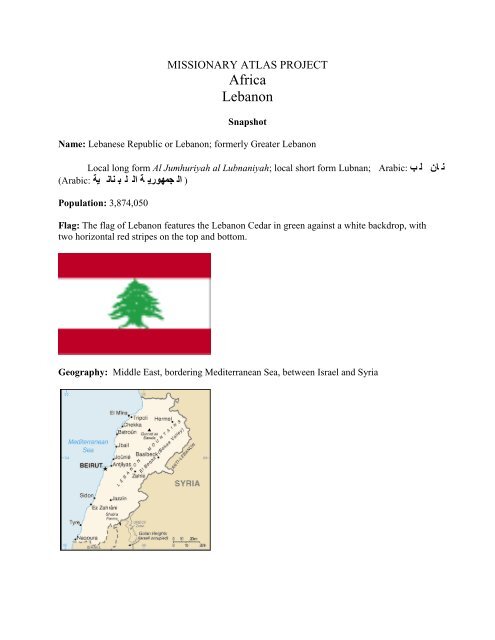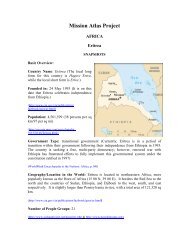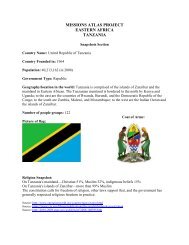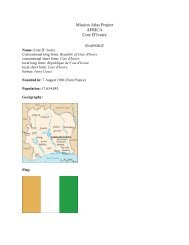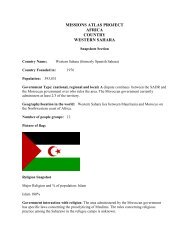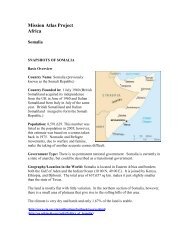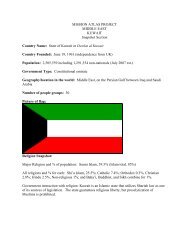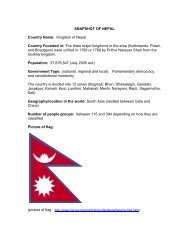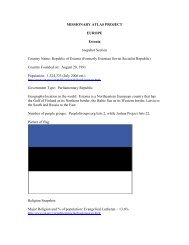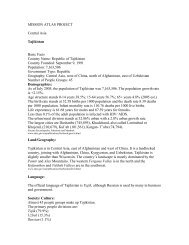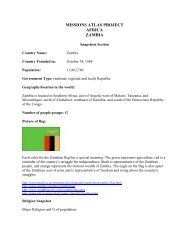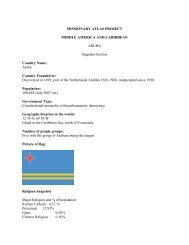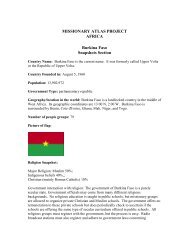Lebanon Profile.pdf - WorldMap
Lebanon Profile.pdf - WorldMap
Lebanon Profile.pdf - WorldMap
You also want an ePaper? Increase the reach of your titles
YUMPU automatically turns print PDFs into web optimized ePapers that Google loves.
MISSIONARY ATLAS PROJECTAfrica<strong>Lebanon</strong>SnapshotName: Lebanese Republic or <strong>Lebanon</strong>; formerly Greater <strong>Lebanon</strong>ن ان ل ب Arabic: Local long form Al Jumhuriyah al Lubnaniyah; local short form Lubnan;) ال جمهوري ة ال ل ب نان ية (Arabic:Population: 3,874,050Flag: The flag of <strong>Lebanon</strong> features the <strong>Lebanon</strong> Cedar in green against a white backdrop, withtwo horizontal red stripes on the top and bottom.Geography: Middle East, bordering Mediterranean Sea, between Israel and Syria
Capital: BeirutIndependence: 22 November 1943 (from League of Nations mandate under FrenchadministrationLanguages: Arabic (official), French, English, ArmenianLiteracy: Total population 87.4%; males 93.1%, females 82.2%Religions:Islam 59.7% (if Druze are counted as Muslim, the figure would change to 65.7%.1,961,200 Muslims, 229,800 DruzeChristian 31.9% (this figure, however, includes all Catholic and Orthodox Churches).When Catholic, Orthodox, and Marginal Christian groups are subtracted from the totalChristian figure, one gets the following:Government:Catholic/Orthodox/Marginal 618, 697 members 1,047,000 adherentsNon Catholic/Orthodox/Marginal 14,500 members, 25,000 adherents or about 0.0034%<strong>Lebanon</strong> is a Republic with three branches, the Executive, the Legislative, and the Judicial. Lawis a mixture of Ottoman Law, Canon Law, Napoleonic Code, and civil law.Economy:<strong>Lebanon</strong>‟s economy has been seriously damaged by wars and civil unrest. The latest invasion byIsrael in 2006 further damaged a fragile economic situation.Number of people groups:22 (Joshua Project), 11 (peoplegroups.org)Arab- 95%Armenian- 4%Other (Turk, Alawite, etc.)- 1%Many religious groups (Druzes, Alawite, etc., are basically people groups as well.(CIA world fact book)http://en.wikipedia.org/wiki/<strong>Lebanon</strong>
County <strong>Profile</strong>Demographics<strong>Lebanon</strong> has not taken a census since 1932. The 1997 estimated population was 3,111,828, butthis figure, provided by the Lebanese government, does not include Palestinian refugees andforeign workers, mainly Syrian. The CIA World Factbook estimates the population at 3,874,050in July 2006..Densities are highest along the coast and on the lower western slopes of the <strong>Lebanon</strong> Mountains.Some 88 percent of the population is urban. Emigration from <strong>Lebanon</strong> to other countries,especially among Christians, has been steady since the mid-19th century, and it increased sharplyduring the civil war. Within the country, thousands of Shiite Muslim refugees fled fighting insouthern <strong>Lebanon</strong> in the 1990s and moved into shantytowns in Beirut‟s southern suburbs.Population3,874,050 (July 2006 est.)Age structure0-14 years: 26.5%15-64 years: 66.5%65 years and over: 7%Population growth rate1.23% (2006 est.)Birth rate18.52 births/1,000 population (2006 est.)Death rate6.21 deaths/1,000 population (2006 est.)Life expectancy at birthtotal population: 72.88 yearsmale: 70.41 yearsfemale: 75.48 years (2006 est.)Source- CIA World Factbook homepage,http://encarta.msn.com/encyclopedia_761564963_2/<strong>Lebanon</strong>_(country).html#p52CIA FactbookLanguageThe major language that is spoken today in <strong>Lebanon</strong> is Arabic, recognized as the officiallanguage. However, many people speak French since it is taught in the school from kindergarten
up and the French dominated <strong>Lebanon</strong> for so many years. English is another language that isspoken and learned in schools and universities by the Lebanese people.Society/CultureAs in other Arab countries the traditional lifestyle of the Lebanese revolves strongly around thefamily, socializing and hospitality. Western influences, mainly French and American, have giventhe country a cosmopolitan facade, mostly in the main cities. Outside the cities, especially in themountains, the people retain the old customs and traditions. The Lebanese people, despite beingethnically and religiously diverse because of the country's long history of conquest andassimilation, are friendly and hospitable. They are familiar with foreigners' ways and dress andalthough sleeveless tops, miniskirts and shorts are acceptable in Beirut, the rest of the country ismore traditional and modest dress is recommended. This is particularly necessary when visitingmosques and other religious places.Holidays:Ramadan- ninth month of the Muslim yearEid Al-Fitr, the end of Ramandn, a three day festivalEid Al-Adha, a feast at the end of the Hadj (the pilgrimage month tot Mecca)The First of Muharram, the Muslim New YearAshura- a Shi‟ite commemoration and day of mourningThe prophet Muhammad‟s birthdayEaster- celebrated on two dates for the Greek Orthodox and for the Protestants and CatholicsNew Year‟s Day- Jan. 1St. Maroun‟s Day- the patron saint of Maronite Christians, Feb. 9The Day of the Ascension- May 15The Feast of the Assumption- August 15Christmas- Dec. 25Boxing Day- Dec. 26Labor Day- May 1Martyr‟s Day- honors patriots killed by the Turks during World War I on May 6Independence Day- Nov. 22They can also be very superstitious. Within Muslim societies, they believe in good luckand evil spirits. One can find charms around peoples‟ necks, in their cars, homes, and evengrocery stores. The evil eye is a good example of a charm. It is an oval eye with a blue dot inthe middle. It keeps away evil spirits and bad luck. Also one can find the hand of Fatimahwhich is a hand with four fingers. Sometimes they will even use verse from the Quran to keepaway evil spirits.The idea of family is so important within Lebanese culture. Children tend to live withtheir parents until they get married. Most businesses are family owned and run, and the revenuesent back by family members working abroad has kept the Lebanese economy afloat during thedifficult war years. People who live in the cities have a fairly Western style of living and mosthave small families, averaging about two children each. Rural families, on the other hand, liveon family owned farms and have bigger families, sometimes ten to fifteen children.
Source: http://www.arab.net/lebanon/ln_people.htm, WORLDMARK: Encyclopedia of Cultures and Daily LifeGovernmentAs defined by the constitution of 1926 and subsequent amendments, <strong>Lebanon</strong> is an independentrepublic. Executive power is vested in a president (elected by the legislature for six years) and aprime minister and cabinet, chosen by the president but responsible to the legislature. Under anagreement dating back to the French mandate, the president must be a Maronite Christian, theprime minister a Sunni Muslim, and the president of the National Assembly a Shi‟i Muslim. TheTaif Accord of 1989 set the Christian-Muslim balance in parliament at fifty-fifty, but the failureof Christians to participate in the elections of 1992 and 1996 gave Muslim groups the largestnumber of seats in the Chamber. There has been no official census in the country since 1932, butmost observers believe Muslims now form the majority with the Shiites as the largest singlegroup.On the local government level, <strong>Lebanon</strong> is divided into five provinces (muhafazat) of Beirut,North <strong>Lebanon</strong>, South <strong>Lebanon</strong>, Bekaa, and Mount <strong>Lebanon</strong>, each with its districtadministration.There are such things as religious courts found in <strong>Lebanon</strong>. There are separate religious courtsfor the Islamic, Christian, and Jewish faiths. They deal with marriages, deaths, inheritances, andother matters of personal status in their respective faiths. There is also a separate military courtsystem dealing with cases involving military personnel and military related issues.The law provides for the right to a fair public trial and an independent and impartial judiciary. Inpractice, politically influential elements succeed in intervening to obtain desired results.Matters of state security are dealt with by a five-member Judicial Council. The Judicial Councilis a permanent tribunal, and the cabinet, on the recommendation of the Ministry of Justice,decides whether to bring a case before Judicial Council.In the refugee camps, the Palestinian elements implement an autonomous system of justice inwhich rival factions try opponents without any semblance of due process. Hezbollah appliesIslamic law in the area under its control.Source: CIA World Fact Book; WORLDMARK: Encyclopedia of the Nations, Asia and Oceania, Tenth EditionEconomy<strong>Lebanon</strong> relies heavily on its trade with different countries, agriculture, and tourism. The 1975-76 war wreaked havoc on the Lebanese economy causing an estimated $5 billion in propertydamage and reduced economic activities to about 50% of the prewar level. The cost ofreconstruction after the Israeli-Palestinian-Syrian war of 1982 was estimated at $12-15 billion.<strong>Lebanon</strong> was able to withstand economic devastation because of help from abroad from suchcountries as the US, France, Germany, and Arab countries, and foreign subsidies to various
political groups. The economy hit another low because of the 1982 war and affected it for manymore years. In 1987, inflation had risen to 487%. After the 1989 Taif Accord for NationalReconciliation ended hostilities, the economy began to recover. Economic activity surged in1991, and in 1993 the Hariri Government was able to stabilize the economy, and launch aprogram to reconstruct the economy‟s infrastructure. In 1997, unemployment remained high atabout 18% although inflation had been reduced to around 5% by 1998. Gross domestic product(GDP) totaled $21.8 billion in 2004, with the GDP expanding by an average of 4.4 percentannually in the period 2000–2004.Source: WORLDMARK Encyclopedia of the Nations, Asia & Oceania, p.342http://encarta.msn.com/encyclopedia_761564963_5____20/<strong>Lebanon</strong>_(country).html#s20LiteracyLiteracydefinition: age 15 and over can read and writetotal population: 87.4%male: 93.1%female: 82.2% (2003 est.)Elementary school education is made free by the government and is required for all for fiveyears. <strong>Lebanon</strong> considers education to be so important for the future of their country. Beirut ishome to six major universities: The American University of Beirut, The Jesuit-sponsored SaintJoseph University, The government-supported Lebanese University, The Beirut Arab University,The Lebanese American University, and The Armenian Haigazian College. <strong>Lebanon</strong> also hasmore than 100 technical, vocational, and other specialized schools and colleges.Source: CIA World Factbook homepage, http://www.arab.net/lebanon/ln_education.htmLand/Geography<strong>Lebanon</strong> is a tiny county, with an area of only a little more than 10,400 sq km (4,000 sq mi)-about the size of the state of Connecticut. It lies on the east coast of the Mediterranean Sea,north of Israel, south of Turkey, south and west of Syria, and northeast of Cyprus. It has twomountain ranges, a coastal strip, an inland plain, dozens of rivers, and four lakes. <strong>Lebanon</strong> hasbeen famous for its cedars, but due to centuries of cutting and herds of goats eating the seedlings,very few cedars are left. Those that remain are now protected. The rainy season lasts from mid-November through March, with very heavy rains at times causing flooding due to poor drainage.Summers on the coast are hot and humid; the mountains are somewhat cooler and breezier.<strong>Lebanon</strong> has a lush and rich soil and can grow so many different types of plant life such asolives, citrus fruits, apples and grapes.Source: WORLDMARK Encyclopedia of Cultures and Daily Life Volume 3: Asia & OceaniaHistory
Early Times<strong>Lebanon</strong>'s long and often turbulent history reaches back to the dawn of civilization peoples haveoccupied the coastal plain and the Bekáa Valley since the Old Stone Age, or Paleolithic, roughly7,000 to 9,000 years ago. Several waves of people, mostly Semites, entered the region from theArabian Peninsula. By 2800 BC, cedar timber from Byblos was being traded for metals andivory from Egypt. They established cities at Beirut, Byblos, Tyre, Sidon, and Baalbek.About 2200 BC, Semitic Amorites arrived from Arabia and Syria. From the westernAmorites, the Canaanites evolved along the full length of the eastern shore of the MediterraneanSea. During succeeding centuries the Canaanites developed the most favored coastal villages intocelebrated city-states: Tripoli, Byblos, Beirut, Sidon, and Tyre.By about 1100 BC the northern Canaanites became known as Phoenicians. The namecame from the Greek word phoinos, meaning “red,” a reference to the unique purple dye thePhoenicians produced from murex seashells. The Phoenicians developed 22-letter Phoenicianalphabet that they spread throughout the region. This alphabet was one of the earliest.The Phoenicians mastered the art of navigation and they dominated the MediterraneanSea trade for 400 to 450 years. They established cities at Beirut, Byblos, Tyre, Sidon, andBaalbek and influenced surrounding peoples for centuries. Phoenicians surrendered to andadjusted to successive conquerors: Assyrians in 867 BC; Babylonians in the 590s BC; Persians in538 BC; and Greeks under Alexander the Great in 333 BC. Phoenician trade declined with Greekcompetition after the 5th century BC.After this succession of different rulers, <strong>Lebanon</strong> became part of the Roman Empire in 64BC. The Romans began an imperial rule over the area that continued under the ByzantineEmpire (Eastern Roman Empire) for 573 years. Under Rome, Phoenicians prospered again asthey rebuilt fleets and made great cultural progress.Aramaic replaced Phoenician as the main language and by the 4th century Christianitywas firmly established. During the early years of the Christian era, when theological differencesbred numerous break-away sects, <strong>Lebanon</strong> became a refuge for religious minorities fleeingpersecution.In the 7th century, the Christian sect that was later to become the Maronite church settledin the northern districts of the Lebanese Mountains to avoid conversion to Islam. The Arabs,inspired by the teachings of the Prophet Mohammed, had converted most of the region to Islam.The geographical inaccessibility that made <strong>Lebanon</strong> attractive as a religious refuge also appealedto Muslims. Shiites found a haven in <strong>Lebanon</strong> during the 9th century and the Druzes in the 11thcentury. The country allowed the different religious groups to exist, but this openness hamperedunity of the country as a whole.The Sidonians grew wealthy with their invention of blown glass. The Roman influenceon the regional culture can be clearly seen in the majestic ruins of Roman temples in <strong>Lebanon</strong>,particularly in Baalbek. Beirut‟s School of law became famous while the region was under
Roman rule. The Semitic Phoenician language yielded to the regionally spoken Semitic Aramaic,introducing new elements to Phoenician culture.Under the Orthodox Byzantines, Christianity became deeply rooted. In the 6th centuryAD monks introduced silkworms from China, and a silk industry developed that brought wealthfor centuries. Around the same time, earthquakes destroyed Beirut and its law school and badlydamaged the great temples in Baalbek.Arab conquests in the 7th century brought political and cultural upheavals to the entireMiddle East including <strong>Lebanon</strong>. In the late 7th century, Maronite Christians, seeking refuge fromByzantine oppression, migrated from the interior of Syria into the northern <strong>Lebanon</strong> Mountains.Gradually, the area named Phoenicia became Mount <strong>Lebanon</strong> or simply <strong>Lebanon</strong>.In 661 a Muslim empire under the Umayyad caliphate arose and placed its capital inDamascus (present-day Syria). The Umayyads incorporated the Fertile Crescent, including<strong>Lebanon</strong>, into their empire. In 750 the Umayyads were overthrown by the Abbasid Caliphate,which ruled from Baghdad.Early in the 11th century a heretical group, the Druze, emerged from the Ismailite Shias.Named Druze after one of their leaders, they evolved in the Mount Hermon area in the southeastof present-day <strong>Lebanon</strong>. Later, some Druze filtered north into the southern <strong>Lebanon</strong> Mountains.The decline of the Abbasids after the 11th century opened the Levant to several contendingpowers, among them the Seljuks. Their territorial advances, especially into Palestine, arousedChristian fears in Western Europe and provoked the invasion of the Crusaders between 1095 and1291.Crusader influence was strong in <strong>Lebanon</strong>, which was divided between the kingdoms ofTripoli and Jerusalem. During Crusader occupation, Maronites cooperated with their fellowChristians and enjoyed expanded group identity. This collaboration increased the suspicions ofMuslims. Between the 11th and 13th centuries, Shia Muslim groups from several areaspeacefully migrated into <strong>Lebanon</strong>‟s northern Bekáa and also later to the south.<strong>Lebanon</strong> then became a shared region by Maronites, Druze, Sunnis, and Shias. Thesesame groups would clash in the civil war of 1975 to 1991. As the 13th century closed, EgyptianMamluks led to the expulsion of the Crusaders and occupied the <strong>Lebanon</strong> area. For more than200 years under the Mamluks, <strong>Lebanon</strong>‟s coastal cities prospered from revived trade.Under Ottoman RuleIn 1516 the Ottoman Turks conquered the entire eastern Mediterranean coast. <strong>Lebanon</strong>became part of the Ottoman Empire. For three centuries the Ottomans granted local leadersrelative autonomy. Under the Ottoman overlords, amirs (princes) of two local dynasties ruledsuccessively: the Maans (1516-1697) and the Shihabs (1697-1842), both Druze families. Maanamir Fakhr al-Din II (1586-1635), a tolerant Europeanized Druze, introduced Western-styledevelopment. The later amirs of the Shihabs became Maronites and, under Bashir II (1788-1840), turned against their Druze neighbors.
Under Ottoman rule, <strong>Lebanon</strong> developed economic and religious ties with Europe. Itsopenness to the West resulted in its becoming a hot bed of political strife between variousforeign nations including France, Russia and Britain. These powerful countries assumed theprotection of certain ethnic- religious groups. France supported the Christian Maronites.In 1860, a bloody civil war culminated in a massacre of the Maronites by the Druze. TheDruze massacred more than 10,000 Christians, mostly Maronites. European powers landedforces to stop the fighting and encourage better and more open administration. Britain andFrance intervened and pressured the Turks into establishing a new Christian-dominatedadministration for <strong>Lebanon</strong> which lasted until World War I. A relative freedom emerged as aresult, attracting Arab intellectuals and foreign missionaries.After World War I, the League of Nations awarded <strong>Lebanon</strong> to France as a mandate.During the 1920s the French redefined <strong>Lebanon</strong>'s borders, combining the largely Musliminhabitedcoastal plain with the Christian-dominated mountains to create the Republic of<strong>Lebanon</strong>. The mandate combined the mainly Christian <strong>Lebanon</strong> Mountains with the mainlyMuslim coastal plain (formerly Phoenicia) and the Muslim Bekáa (including some of the Anti-<strong>Lebanon</strong> mountain ridges) to form “Greater <strong>Lebanon</strong>,” marking the creation of <strong>Lebanon</strong> as it isknown today.The combination made the new country far more viable. From 1926 when France forgeda dependent Republic of <strong>Lebanon</strong> the modern nation emerged as an independent state in 1943.Conflict between the ethnic and religious groups, however, developed. <strong>Lebanon</strong> remained underFrench mandate until 1943, when <strong>Lebanon</strong> became fully independent.Modern TimesFor a while after the independence of 1943, independent <strong>Lebanon</strong> was a modelecumenical society. Its strategic Middle Eastern location and relatively stable government madeit a major trade and financial center. Lebanese political leaders forged an unwritten National Pactdesigned to promote cooperation and conciliation among the rival religious groups.The concept of a confessional democracy was unique. The National Pact was partly basedon the 1932 census, which ranked the major sects in order of population as Maronites, SunniMuslims, Shia Muslims, Greek Orthodox, Druze, and Greek Catholics. Among the pact‟sprovisions, Maronites and Sunni Muslims were assured dominant political roles in proportion totheir 1932 populations. Peace did not, however, last because the Christians had more controlwithin the government and the Muslims felt excluded from the political realm.A second problem arose. <strong>Lebanon</strong> was gradually drawn in to the Arab-Israeli conflict.Although the country did not actively participate militarily, displaced Palestinian Muslimrefugees flooded into the country and continued their attacks on Israel from Lebanese bases.In 1958 a Muslim rebellion ended when American marines landed in Beirut.
In the summer of 1975 all-out civil war broke out between the Muslim coalition allied withPalestinian groups and the Christian-dominated militias. This tension arose partially from actionsof President Camille Chamoun who provoked political foes, especially Druze and SunniMuslims, by challenging the constitution in an attempt to gain a second term. The United States,fearing the war‟s effect on the wider region, intervened on July 15. The Marines‟ presencehelped stabilize the country, and by early August the fighting was finished. In three months ofwarfare, an estimated 2,000 to 4,000 people were killed.In April 1976, an uneasy cease-fire was forced upon the two sides when Syrian militaryforces intervened at the request of the Lebanese president, Suleiman Franjieh and with theapproval of the Arab League of States. Nevertheless sporadic violence continued. In 1978 Israelinvaded southern <strong>Lebanon</strong> in an attempt to eliminate Palestinian bases.Withdrawing three months later after a United Nations peacekeeping force was sent tothe area, they reinvaded in 1982, occupying Beirut and forcing the PLO to evacuate its headquarters. For seven weeks the Israelis relentlessly bombed the Muslim half of Beirut by air, seaand land. The USA arranged for the evacuation of PLO fighters to other Arab Countries, and amultinational Force of US and West European troops was deployed to Beirut to protectPalestinian and Muslim civilians.After the assassination of president-elect Bashir Gemayel, Israeli-backed Christianmilitias massacred Palestinian civilians in the Sabra and Chatila camps in West Beirut. A yearlater Israeli troops withdrew to southern <strong>Lebanon</strong>. No sooner had they left when fighting brokeout between <strong>Lebanon</strong>'s Christian and Druze militias, and terrorist attacks on the multinationalforce including the US marine headquarters at Beirut airport resulted in hundreds of casualties.After 300 US and French troops were killed on October 23, 1983, the Western forces pulled out.Factional fighting continued and Westerners in Beirut became the targets of radical ShiiteMuslims with an allegiance to Iran.In 1988 a parliamentary power struggle led to the formation of rival Christian andMuslim governments. In 1989 the Lebanese parliament accepted an Arab-brokered peace accordfor national reconciliation. MPs elected Maronite Rene Mooed as president who was assassinated17 days later. With the help of the Syrians, the Lebanese army took control of Beirut and by1992 under pressure from Iran and the US, all the foreign hostages captured several years earlierwere released.Until the Lebanese Civil War (1975-1990), the country enjoyed relative calm and prosperity,driven by the tourism, agriculture, and banking sectors of the economy. <strong>Lebanon</strong> was consideredthe banking capital of the Arab world and was known as the "Switzerland of the Middle East"due to its financial power but also because of its beauty. <strong>Lebanon</strong> was chosen over Switzerlandfor skiing competition for Europe at one time. <strong>Lebanon</strong> also attracted large numbers of tourists.Beirut became widely referred to as the "Paris of the Middle East."In 1992 Mr. Rafik Al Hariri was appointed Prime Minister of <strong>Lebanon</strong>. Mr. Haririinitiated many projects to redevelop war torn <strong>Lebanon</strong>, especially the capital Beirut, and bring itback to its former glory. Mr. Hariri and Lebanese President Elias Hrawi strove to develop the
Lebanese economy and moral by rebuilding war-torn areas and trying to move on despite somany lost lives throughout the years.The extensive efforts to revive the economy and rebuild national infrastructure resultedin a considerable degree of stability throughout much of the country. Beirut's reconstruction wasalmost complete. An increasing number of foreign tourists were pouring into <strong>Lebanon</strong>'s resorts.However, the 2006 Israel-<strong>Lebanon</strong> conflict brought mounting casualties, extensive damage to theinfrastructure, and massive population displacement.This 2006 Israel-<strong>Lebanon</strong> conflict, known in <strong>Lebanon</strong> as the July War and in Israel as theSecond <strong>Lebanon</strong> War, involved conflict in <strong>Lebanon</strong> and northern Israel. The fighting wasprimarily between Hezbollah paramilitary forces and the Israeli military. The conflict began onJuly 12, 2006, and continued until a ceasefire arranged by the United Nations took effect onAugust 14. The war formally ended on September 8 when Israel ceased their naval blockade of<strong>Lebanon</strong>.The war actually began when Hezbollah fired Katyusha rockets and mortars at Israelimilitary positions. These attacks diverted attention from another Hezbollah unit that crossed theborder, and kidnapped two Israeli soldiers, and killed three others. Israeli troops lost five moremen attempting without success to rescue the abducted soldiers. Israel responded with air andartillery strikes on Lebanese targets, including Rafik Hariri International Airport. Israel chargedthat Hezbollah used this airport to import weapons. The Israeli armed forces instituted an air andnaval blockade and a ground invasion of southern <strong>Lebanon</strong>. Hezbollah retaliated with rocketsinto northern Israel and faced the Israel Defense Forces (IDF) from prepared defensive positions.The conflict killed over 1,400 people, most of whom were Lebanese civilians, severelydamaged Lebanese territory, displaced about 900,000 Lebanese and 300,000 Israelis, anddisrupted normal life across <strong>Lebanon</strong> and northern Israel. Even after the ceasefire, 256,000Lebanese remained displaced, and much of Southern <strong>Lebanon</strong> remained uninhabitable due tounexploded bombs.On August 11, 2006, the United Nations Security Council unanimously approvedResolution 1701 in a peace effort. The resolution, approved by both Lebanese and Israeligovernments, called for the disarming of Hezbollah, the withdrawal of Israel, the deployment ofLebanese military, and an enlarged United Nations Interim Force in <strong>Lebanon</strong> (UNIFIL) insouthern <strong>Lebanon</strong>.The Lebanese army began deploying in southern <strong>Lebanon</strong> on August 17. The blockadewas lifted on September 8. By October 1, 2006, most Israeli troops withdrew from <strong>Lebanon</strong>,though the last of the troops continued to occupy the border-straddling village of Ghajar untilDecember 3, 2006. The effects of this war will continue for years. The internal situation in<strong>Lebanon</strong> cries out for extensive help.Source: http://www.arab.net/lebanon/,http://en.wikipedia.org/wiki/<strong>Lebanon</strong>;http://encarta.msn.com/encyclopedia_761564963_8/<strong>Lebanon</strong>_(country).html#p93
Christian HistoryChristianity arrived during the Byzantine Roman era (AD 4-636) and its followers in <strong>Lebanon</strong>have since become divided into a variety of sects including Maronite, Roman Catholic, GreekCatholic, Greek Orthodox, Armenian Catholic, Armenian Orthodox, and Protestant. During theearly years of the Church, <strong>Lebanon</strong> had become an area where many Christian heretical groupsfled and spread their wrong teachings.Non-Christian:ReligionsIslamIslam claims up to 59.76 % of the people of <strong>Lebanon</strong> or some 1,961, 196. Islam is said to begaining at a rate of + 3.5 % annually. Islam in <strong>Lebanon</strong> is, however, divided into a number ofdistinct groups. The total percentage of Islamic people would rise by 7 % if one considers theDruze as Islamic as this profile does. With the Druze, Islam can claim 66.97% of the people.SunniSunni Muslims are those that follow only the teachings of the prophet Mohammad andthe Quran. They do not recognize the need for a priesthood to mediate the faith to thecommunity of believers. The Sunnis, especially the Wahhabis of Saudi Arabia, stand forthe original simplicity of Islam.Religious leadership of the Sunni community in <strong>Lebanon</strong> is based on principles andinstitutions deriving partly from traditional Islam and partly from French influence.Under the Mandate, the French established a Supreme Islamic Council at the nationallevel, headed by a Grand Mufti and a national Directorate of Waqfs; these institutionscontinued to exist in the mid-1980s. The French also established local departments ofwaqfs, which staffed and maintained hospitals, schools, cemeteries, and mosques. Inaddition, the waqfs managed the funds that supported these operations.Shaykh is an honorary title given to any Muslim religious man in <strong>Lebanon</strong>. As a result ofthe 1975 Civil War and the intensification in sectarian mobilization and identification, thereligious leaders of the Sunni community assumed a more political role, especially withthe advent of Islamic fundamentalism in <strong>Lebanon</strong>. As of 1987, the Sunni mufti, ShaykhHasan Khalid, was the most powerful Sunni leader; he headed what was called theIslamic Grouping, which was composed of all Sunni traditional leaders. The SunniUlama (learned religious men) of <strong>Lebanon</strong> emulated the Shia practice of combiningtemporal and religious power in the person of the imam.In 1987 the majority of Lebanese Sunnis resided in urban centers. It is estimated thatmore than two-thirds of them lived in Beirut, Sidon, and Baalbek. The few rural Sunnislived in the Akkar region, the western Biqa Valley, around Baalbek, and in the Shuf
Mountains. Their typical occupations were in the realms of trade, industry, and realestate. Large Sunni families enjoyed political and social significance.The Kurds are non-Arab Sunnis of whom there are only a few in <strong>Lebanon</strong>, concentratedmainly in Beirut. They originated in the Taurus and Zagros Mountains of Iraq, Iran,Turkey, and Syria. The Kurds of <strong>Lebanon</strong> tended to settle there permanently because of<strong>Lebanon</strong>'s pluralistic society. Although they are Sunni Muslims, Kurds speak their ownlanguage.Twelver or Imami ShiasLeadership of the Shia community is held by the Imam, which they believe is descendedfrom Ali. A son usually inherited the office from his father. In the eighth century,however, succession became confused when the Imam, Ja‟far al Sadiq, first named hiseldest son, Ismalil, his successor, then changed his mind and named a younger son, Musaal Kazim. Ismail died before his father and thus never had an opportunity to assert hisclaim. When Jafar died in 765, the imamate entrusted on to Musa.Those Shia who followed Musa are known to Western scholars as the Imami or TwelverShias. The part of the community that refused to acknowledge Musa's legitimacy andinsisted on Ismail's son's right to rule as imam became known as Ismailis.The name “Twelver” relates to the disappearance of the twelfth imam, Muhammad alMuntazar, in about 874. He was a child, and after his disappearance he became known asa messianic figure, Ali Mahdi, who never died but remains to this day hidden from view.The Twelver Shias believe his return will usher in a golden era.In the mid-1980s the Shias generally occupied the lowest stratum of Lebanese society;they were peasants or workers except for a small Shia bourgeoisie. The Shias wereconcentrated chiefly in the poor districts of southern <strong>Lebanon</strong> and the Biqa. From theserural areas, stricken by poverty and neglected by the central government, many Shiasmigrated to the suburbs of Beirut.IsmailisThe Ismailis are Shias known as Seveners because they believe Ismail was the seventhImam. The Ismaili sect is divided into two branches: the Mustalian branch is foundprimarily in North Yemen, and the Nizari branch is found in the Iranian district ofSalamiya, Afghanistan, Soviet Central Asia, India, the hitral and Gilgit areas of Pakistan,and East Africa. Ismaili beliefs are complex and syncretic, combining elements from thephilosophies of Plotinus, Pythagoras, Aristotle, gnosticism, and the Manichaeans, as wellas components of Judaism, Christianity, and Eastern religions. Ismaili tenets are uniqueamong Muslims. Ismailis place particular emphasis on taqiyya, the practice ofdissimulation about one's beliefs to protect oneself from harassment or persecution.Ismaili beliefs are kept in secret and are there fore very hard to understand what theyactually believe in.
AlawisThe Alawis are also known as "Nusayris" because of their concentration in theNusayriyah Mountains in western Syria. They appear to be descendants of people wholived in this region at the time of Alexander the Great. When Christianity flourished inthe Fertile Crescent, the Alawis, isolated in their little communities, clung to their ownpre-Islamic religion. After hundreds of years of Ismaili influence, however, the Alawismoved closer to Islam. Furthermore, contacts with the Byzantines and the Crusadersadded Christian elements to the Alawis' new creeds and practices. For example, Alawiscelebrate Christmas, Easter, and the Epiphany, and use sacramental wine in someceremonies. They enjoyed some freedom under Ottoman rule, but then that all changedand the Ottomans started to repress them. They were seen as infidels.Alawis are not considered to be Muslims by the Sunni Muslims. However, the Alawissee themselves as genuine Muslims. In the early 1970s, Imam Musa as Sadr declared theAlawi sect a branch of Shia Islam. Like Ismaili Shias, Alawis believe in a system ofdivine incarnation. Unlike Ismailis, Alawis regard Ali as the incarnation of God. Becausemany of the tenets of the faith are secret, Alawis have refused to discuss their faith withoutsiders. Only an elect few learn the religion after a lengthy initiation process. Alawisstudy the Quran and recognize the five pillars of Islam.. Alawis do not set aside aparticular building for worship. In the past, Sunni government officials forced them tobuild mosques, but these were invariably abandoned. Only the men take part in worship.DruzesThe religion of the Druzes may be regarded as an offshoot of Ismaili Islam. Historically itsprings from the Fatimid Caliph of Egypt, Hakim (996-1021 A.D.), who consideredhimself the final incarnation of God. His close associates and followers Hamza andDarazi (hence the name Druze) spread the new doctrine among the inhabitants ofsouthern <strong>Lebanon</strong>. The Druzes believe that Hakim is not dead but absent and will returnto his people. Like the Ismailis, they also believe in emanations of the deity, insupernatural hierarchies, and in the reincarnation of souls.The Druzes are religiously divided into two groups. Those who master the secrets andteaching of the sect and who respect its dictates in their daily life, are referred to as uqqal(the mature) and are regarded as the religious elite. Believers who are not entitled toknow the inner secrets of the religion and who do not practice their religion are calledjuhhal (the ignorant).Source: http://lcweb2.loc.gov/frd/cs/lbtoc.htmlCatholics/Orthodox ChurchesIn many circles, Catholic and Orthodox groups are considered under the overall category of“Christian.” Christians under these rankings comprise 31.93 % of the people in <strong>Lebanon</strong> or
some 1,047,875. If the Catholic and Orthodox statistics are taken out of the “Christian”categories, the percentage of Christians in <strong>Lebanon</strong> shrinks to around 0.034%.MaronitesThe Maronites are the largest Eastern Church in <strong>Lebanon</strong>. Maronite communion with theRoman Catholic Church was established in 1182, broken thereafter, and formallyreestablished in the sixteenth century. In accordance with the terms of union, they retaintheir own rites and canon law and use Arabic and Aramaic in their liturgy as well theKarshuni script with old Syriac letters. Their origins are uncertain.In the late seventh century, as a result of persecutions from other Christians for theheterodox views they had adopted, the Maronites withdrew from the coastal regions intothe mountainous areas of <strong>Lebanon</strong> and Syria. During the Ottoman era (1516-1914) theyremained isolated and relatively independent in these areas. Later on, clashes beganbetween them and the Druzes. The conflict led France to send a military expedition tothe area in 1860. The disagreements diminished in intensity only after the establishmentof the Mandate and a political formula whereby all sects achieved a degree of politicalrepresentation.Most Maronites have historically been rural people, but are also scattered throughout thecountry. The urbanized Maronites reside in East Beirut and its suburbs. The Maronitesect has traditionally occupied the highest stratum of the social pyramid in <strong>Lebanon</strong>.They occupy many leadership roles and are heavily involved the political realm of thecountry.The Manonite Patriarchate reports 545 congregations with as many as 370,200 membersand over 570,000 affiliates. The report of the group in 1990 showed 850 congregationsand 575000 members in 1980.Melchite Catholic PatriarchateThe Church claims 198 congregations with 61,622 members in 2000. The group hadcounted 96000 members in 1970.Greek CatholicsThe Greek Catholics emerged as a distinct group in the early eighteenth century whenthey split from the Greek Orthodox Church. Although they fully accept Catholicdoctrines as defined by the Vatican, they have generally remained close to the GreekOrthodox Church, retaining more of the ancient rituals and customs than have theMaronites. They use Arabic and follow the Byzantine rite.In <strong>Lebanon</strong>, when one speaks of Catholics, one is referring to this group, not to RomanCatholics or the Maronites. They are typically very educated and reside in Beirut, Zahle,and the suburbs of Sidon.
Roman CatholicsCatholics who accept the full primacy of the Holy See and follow the Latin ritecomprised less than 1 percent of the population in the 1980s. The Lebanese refer to themas Latins. As Roman Catholics, they acknowledge the supreme authority of the Pope inRome, venerate the Virgin Mary and the saints, and recognize the seven sacraments suchas baptism, confirmation, the Eucharist (the sacrament of the Lord's Supper), confessionand penance, ordination, matrimony, and anointing of the sick.This Catholic group claims 9 congregations with over 5600 members and as many as10,000 adherents.Greek OrthodoxThe Greek Orthodox adhere to the Orthodox Eastern Church, which uses the Byzantinerite. The final split took place after the fall of Constantinople in 1096. From that time,with the exception of a brief period of reunion in the fifteenth century, the EasternChurch has continued to reject the claim of the Roman patriarchate to universalsupremacy, and has also rejected the concept of papal infallibility. In present-day<strong>Lebanon</strong>, the Greek Orthodox has become increasingly urbanized, and forms a major partof the commercial and professional class of Beirut and other cities. Many are also foundin the southeast and north, near Tripoli. They are both highly educated and well versed infinance.JacobitesThe Jacobites or Syrian Monophysites, often referred to as the Syrian Orthodox Church,take their name from Jacob Baradeus who spread the teachings of the church throughoutSyria in the sixth century. The doctrinal position of the Jacobites is that after theincarnation, Christ had only one divine nature. This is contrary to the orthodox Christianposition that states Christ had both a human and divine nature.The Syrian Orthodox Church has 4 congregations and over 5000 members.Armenian Orthodox or GregorainThe Gregorian Church was organized in the third century. In the sixth century itmodified the formulations of the Council of Chalcedon of 451 that confirmed the dualnature of Christ in one person. Instead the Gregorian Church adopted a form ofMonophysitism that believes in the single divine nature of Christ, a belief which isslightly different from the belief of the Copts and the Syrian Orthodox Church. It has anArmenian liturgy.The Armenians in <strong>Lebanon</strong> were refugees who had fled Turkey during and after WorldWar I. In 1987 they resided in Beirut and its northern suburbs as well as in Anjar. They
are admired for their skills as craftsmen and diligence, which have enabled them to gainprominent economic positions. Politically, Armenians advocate compromise andmoderation.The Armenian Orthodox Church reports 11 congregations and almost 6000 members.Assyrian or Nestorian ChurchThe Assyrians are the remnants of the Nestorian Church that emerged with theChristological controversies in the fifth century. The Nestorians, who have a Syriacliturgy, stressed that Christ consisted of two separate persons, one human and one divine,as opposed to having two natures in one person. Their doctrine was condemned by theCouncil of Ephesus in 431 A.D. Subsequently, those Nestorians who accepted thisdoctrine formed an independent church, which has only a few thousand members in<strong>Lebanon</strong>.Non-Christians Sectarian GroupJehovah WitnessesJehovah Witnesses claim 70 congregations with 3529 members. The total number ofadherents (members and those with close connections with the JWs) numbers as many as6500. According to the statistics, the Jehovah Witness‟s in <strong>Lebanon</strong> outnumber anyProtestant or Evangelical denomination.Church of Jesus Christ of Latter Day Saints (Mormons)The Mormons have 2 congregations and some 375 members. They show a slow butcontinuing gain since 1960.Protestants/Evangelicals/PentecostalsAs seen above, the percentage of Christians in <strong>Lebanon</strong> is around 4.06% or some 13, 272. TheseChristians are divided into around 31 different groups. The number 14,500 Christians does notcount the 3500 Jehovah Witnesses that are reported.The Protestants in <strong>Lebanon</strong> were converted by missionaries, primarily English and American,during the nineteenth and twentieth centuries. They are divided into a number of denominations,the most important being Presbyterian, Congregational, and Anglican. Typically, LebaneseProtestants are educated and belong to the professional middle class. They constitute less than 1percent of the population and live primarily in Beirut.The Baptist Convention has 22 congregations with some 1300 members and as many as4500 adherents.
The National Evangelical Union has 1800 members in 4 congregationsThe Church of the East reported 3 congregations and 2575 members in 2000 after havingclaimed 3300 members in 1960. The church is experiencing a gradual decline.The Church of God (Anderson) reports 15 congregations with some 1300 members.The Union of Evangelical Armenians has over 1000 members in 23 congregations. Since1960 this group had never reported over 9 congregations but suddenly in 2000 claimed23. The number of members has remained about the same since 1960.The National Evangelical Synod (Presbyterian) has around 1000 members in 13congregations. The group had 23 congregations in 1975 and in 1965 reported 1775members. The group has lost some 10 congregations and 775 members.The Seventh Day Adventists have 5 congregations with around 500 members. This groupreported 13 congregations and over 1000 members in 1970.The National Evangelical Alliance reports 4 congregations with over 330 members.These churches are affiliated with the CMA.The Christian Brethren report 5 congregations with some 350 membersAssemblies of God have 3 congregations with just under 200 members.The Muslim Background Believers Church has 50 congregations with over 2500members. The group has continued since 1960.Sources: http://www.photius.com/countries/lebanon/society/index.html; Operation World11810Alawites (105,101)People GroupsAccording to some sources, they were originally Nusayrīya, a sect that broke ties with TwelverShiites in the 9th century. The Alawites trace their origins to the eleventh Shia Imam, Hasan alAskari (d.873), and his pupil Ibn Nusayr (d.868). Ibn Nusayr proclaimed himself the Bāb "Door"(representative) of the 11th Imam. The sect seems to have been organised by a follower of IbnNusayr's known as al-Khasibi who died in Aleppo in about 969. Al-Khasibi's grandson al-Tabarani moved to Latakia on the Syrian coast. There he refined the Nusayrī religion and, withhis pupils, converted much of the local population.Muslims in Syria and <strong>Lebanon</strong> consider them to be legitimate Muslims, but many other Muslimcountries look at them as being a heretical group. According to Alawite tradition, they camefrom God, and their religion is what Mohammad and Ali taught. Their name means „follower ofAli‟. They have had a long history of persecution. Ibn Taymiyya, the founder of Wahhabism,
issued a fatwa against stating that they were not to be trusted and considered to be greaterinfidels than Jews or Christians. Alawites follow the five pillars to Islam, but add two morewhich are Jihad and worship of Ali. They consider Ali to be part of a Trinity of Allah. They area very secretive group and do not like for their rituals or teachings to be known by non-believers.They are heavy believers of astrology and believe that the stars in the sky are deified souls ofbelievers.They are less than 2% evangelized.Source: http://www.muslimhope.com/Alawites.htm, http://en.wikipedia.org/wiki/AlawiteAssyrian (1,115)11812They are part of the Nestorian church. There are some evangelical resources available to themsuch as the Jesus Film, but they are less than 2% evangelized.11818Christian (1,212,000)There are many Lebanese that call themselves Christian, but that means they were born into anorthodox Lebanese family that has a tradition of belonging to one of the Christian churches in<strong>Lebanon</strong>. Many who call themselves Christians may know the traditions of the Lebanese church,but may not have a personal relationship with Jesus Christ. These people often prefer to becalled Phoenicians. According to peoplegroups.org, they are less than 2% evangelized.11815Druze (252,500)In <strong>Lebanon</strong>, Syria and Israel, the Druze have official recognition as a separate religiouscommunity with its own religious court system. Their symbol is represented by five colors: greenfor the “Universal Mind”, red for the “Universal Soul”, yellow for the “Truth/Word”, blue for the“Antagonist/Cause”, and white for the “Protagonist/Effect”.Although often politically recognized as Muslims, most Druze do not consider themselvesMuslims, since they are not followers of the five pillars of Islam.Gospel recordings are available to the Druze a radio broadcast as well. They are less than 2%evangelized, but there has been a church planting movement started within the past two years.11816Iraqi Arab (12,738)They have migrated Iraq for various reasons such as employment and escaping harsh livingconditions. They adhere to the religion of Islam and are less than 2% evangelized. The JesusFilm is available to them and also the Bible, Gospel recordings, and a radio broadcast.11820Kurmanji (15,766)
They are a Kurdish group found in Beirut, Sidon, Tripoli, and Biqa Valley. They are less than2% evangelized. The Jesus Film is available in their tongue. There are Gospel recordingsavailable and so is the Bible.42760Palestinian Arab (386,393)The Palestinian Arabs migrated to <strong>Lebanon</strong> as refugees to escape the war in Israel. Many live incramped refugee camps, in poor living conditions. The refugee camps are like cities themselveswith schools, markets, and a judicial court. Many are without hope of ever leaving these camps.They are less than 2% evangelized, with a Christian radio broadcast and some Gospel recordings.22026Shiite (1,366,313)There is a large Shiite group present in <strong>Lebanon</strong> that has a strong level of influence in thepolitical realm. They are less than 2% evangelical, but there is a small local church plantingmovement present among the Shiite group.22028Sunni (868,450)This is the other popular major Muslim group present in <strong>Lebanon</strong>. They hold the position ofprime minister in the Lebanese government. They are less than 2% evangelized. There is aChristian radio broadcast available to them, but no visible church planting movement.11823Turk (3,347)The Turks that are present in <strong>Lebanon</strong> are predominately Muslim that have mainly come to<strong>Lebanon</strong> for employment purposes. They are currently less than 2% evangelical, with no visiblechurch planning movement. The Bible and Jesus Film are available to them.00000Americans (3,300)Many of the Americans who live in <strong>Lebanon</strong> are either studying there or are working with acompany. Many are considered to be well off. They tend to live in their own communities orwhere other foreigners reside. They are considered to be highly evangelized.00000Egyptian Arab (59,000)Many who live in <strong>Lebanon</strong> are there seeking employment opportunities. Many of them alsoleave behind their families in Egypt and see them on the holidays. They save up their earningsand send it back home to their families. They are considered to be an unreached people groupand have very few believers.00000Levantine Arab (2,401,000)
These are the Arabs that come from the Middle East such as Jordan, Palestine, and Iraq. Manyof them have come to <strong>Lebanon</strong> to seek employment opportunities or a better lives forthemselves. Many can be of a poorer class and live in not so good conditions. They areconsidered to be unevangelized and no know church planting movement.00000Syrian Arab (87,000)There are may Syrian Arabs who live in <strong>Lebanon</strong> seeking a better life for themselves andemployment. They are predominately a Sunni Muslim group and very few known Christiansamong this group.00000Armenian (168,000)Armenians have a strong Christian Orthodox background. Many profess to be Christiansbecause they come from Christian families that goes back generations. Many Armenians haveleft their country to escape political turmoil and poor living conditions. There is currently anactive church planting movement within these people.00000British (1,200)The British that are present in <strong>Lebanon</strong> are either seeking employment opportunities or arestudents. They tend to be wealthy and work for major corporations or work for their owngovernment. Many are nominal believers.00000Chaldean, Neo-Aramaic (18,000)They come from Iraq and speak a modern Aramaic or Syriac language. They used to be part ofthe Assyrian Church of the East, but because of a schism that split the church, they joined theRoman Catholic Church and became members of the Eastern Rite Chaldean Catholic Church.Many have left Iraq seeking a better life for themselves. There is a church plating movementamong this group that is growing and reproducing.00000Deaf (Unknown)There isn‟t much known about this group and not much data available on them. They areconsidered to be unreached.00000French (16,000)Many French who live in <strong>Lebanon</strong> are either working or are studying in <strong>Lebanon</strong>. They are mostlikely are considered to be wealthy and live where other foreigners live. They are nominalCatholics, but for the most part do not practice Christianity. There is a growing trend towardbelieving in atheism or in Near Eastern religions such as Buddhism. There are pockets of Frenchwho are accepting Christ and forming fellowships.
00000Greek (3,300)The Greeks that are present in <strong>Lebanon</strong> have come to seek employment opportunities and abetter life for themselves. Many are part of the Greek Orthodox Church and follow its traditions.There is a growing Protestant movement amongst them. There is an accelerating number of newfellowships that are forming within the Greek community.00000Italian (3,300)Many have come to seek job opportunities for themselves. They are predominately a RomanCatholic group. There is a large church planting movement amongst this group.00000Jew (100)There is a small Jewish population in <strong>Lebanon</strong> and are discriminated against by some of theLebanese communities. They are not evangelized and have no church planting movementamongst this group.00000Syrian Jew (50)There is a small Jewish population in <strong>Lebanon</strong> and are discriminated against by some of theLebanese communities. They are not evangelized and have no church planting movementamongst this group.00000Portuguese (1,500)There are many who live in <strong>Lebanon</strong> for job opportunities. Many claim to be part of heChristian faith, but they are mostly nominal believers.00000Spaniard (1,500)They come from strong Catholic backgrounds, but many that come from this generation deny thebeliefs of the Catholic church and consider it to be part of their ancestors not to be believed fortoday. Many who live in <strong>Lebanon</strong> have come to seek job opportunities.Missiological Implications1. Evangelical Christians should mount a vast prayer initiative for the peoples of <strong>Lebanon</strong>.The few Evangelical Christians are under constant pressure. The various Muslim groupshave no power binding them together.2. Evangelical Christians should pray for and work toward a full normalization of politicalrelationship between <strong>Lebanon</strong> and Israel without direct support of the State of Israel. Thiseffort should include seeking a principle of reciprocity for Christians living in Muslim
lands. Christians should seek freedom for Christians in Muslim lands on the same linethat Muslims have in Western societies.3. Evangelical Christians should train people in methods of sharing the Good News withfollowers of Islam. The Christian movement should seek and people who will move intoMuslim territories, <strong>Lebanon</strong> and other Islamic areas, to share the Gospel4. Evangelical Christians should support and aid those seeking to train leaders for theLebanese Churches. Evangelical Christians should seek ways to cooperate in the task oftraining workers.5. Evangelical Christians should seek ways to meet the tremendous physical needs and thecontinuing trauma resulting from wars, persecution, and shortages.6. Evangelical Christians should develop direct ways to contact and evangelize Lebanesecitizens who leave the country for better and safer opportunities.7. Evangelical Christians should seek to help the victims of the political situation in<strong>Lebanon</strong> to find peace with each other and begin to rebuild their nation.8. Evangelical Christians should seek ways to aid the existing Christians and Churches tomove forward in their own spiritual development as well as begin to share the Messagewith their fellow Lebanese.9. Evangelical Christians should seek ways to introduce a viable witness to the manynominal Muslims and others who follow a more Traditional Religion pattern.10. Evangelical Christians should make the most of what freedom of religions exists in<strong>Lebanon</strong>.PicturesLinks –http://en.wikipedia.org/wiki/<strong>Lebanon</strong>http://www.destinationlebanon.gov.lb/eng/index.asphttp://rs6.loc.gov/frd/cs/lbtoc.htmlhttp://www.dailystar.com.lb/https://www.cia.gov/cia/publications/factbook/geos/le.htmlhttp://www.arab.net/lebanon/http://www.infoplease.com/ipa/A0107710.htmlhttp://www.presidency.gov.lb/http://www.lonelyplanet.com/worldguide/destinations/middle-east/lebanon/http://www.lebanonpanorama.com/http://news.bbc.co.uk/1/hi/world/middle_east/country_profiles/791071.stmhttp://web.worldbank.org/WBSITE/EXTERNAL/COUNTRIES/MENAEXT/LEBANONEXTN/0,,menuPK:294909~pagePK:141159~piPK:141110~theSitePK:294904,00.htmlhttp://www.world-newspapers.com/lebanon.html


